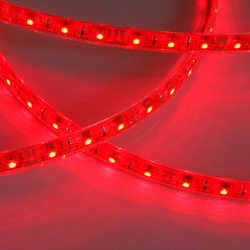Nov 17 2010
Elemental LED, a San Francisco based LED lighting company, now provides solutions to two common problems to indoor gardening: Heat and cost. Elemental LED offers LED grow lights for indoor gardeners that stay cool and use a fraction of the energy of conventional indoor grow lights.
Recent advancements in LED technology have led to the development of LED grow lights using red and blue LED lights.
 Red LED Strip Lights Replace HPS lamps for the Flowering Phase
Red LED Strip Lights Replace HPS lamps for the Flowering Phase
Traditional enclosed gardening projects require the use of high-intensity discharge lamps (HID) to replicate the frequency and intensity of the sun’s rays. The most commonly used types of HID lamps are metal halide (MH) and high-pressure sodium bulbs (HPS). During the vegetative phase, growers use metal halide bulbs (MH) because they emit blue light essential for the “growth” period of a plant’s life. For the flowering phase, gardeners switch to high-pressure sodium bulbs (HPS). HPS lamps emit light in the red/orange spectrum, which triggers plants to begin flowering or budding.
HID lamps are costly to purchase and operate. Growers use 1000W HPS bulbs with a color-rating index (CRI) of 22 and an output of about 100 lumens per watt. In the vegetative phase of a plant’s life, a grower will employ a light cycle of at least 16 hours per day. Some growers will even employ a continuous 24-hour light cycle during this phase. Depending on the size of the garden, the costs of running several 1000W lamps all day for several weeks can lead to astronomical energy bills.
HID lamps output high amounts of heat. 1000W HPS bulbs get so hot, growers must hang them at least 4 to 6 feet from the plant tops to prevent burning. This placement cuts down on the efficacy of the bulb. The optimal distance between the plant and light source is two feet. As the distance between the light source and the plant increases, the lumen intensity decreases, which impedes the growth of the plant. The closer the bulb is to the plant, the better the dispersion of lumens, resulting in a healthier and more productive garden.
Indoor gardening with LED grow lights is practical and energy efficient. Blue LED lights can be used in the vegetative phase to replace MH bulbs, while red LED lights can stand in for HPS bulbs. In comparison to HID lamps, blue and red LED lights typically create one-tenth of the energy costs, and almost zero heat. LED light bulbs can be placed as close to the plants as possible, allowing indoor growers to take full advantage of their lumen output without burning the plants.
Some indoor gardeners require warmer rooms for their plants, and have depended on the heat emitted by HID lamps to warm the space. A small space heater in conjunction with LED lights produces more heat and uses less energy than HID lamps.
Elemental LED offers affordable LED lighting options for the indoor grower:
Waterproof Flexible LED Strip Lights come in red and blue, and can be placed in enclosed boxes or closets to create a small indoor garden. At only 1.5 watts per foot, they use a small fraction of the energy of HID lamps, and require one power source for every 30 feet of lighting. Since they are waterproof, these lights are effective in hydroponic gardens.
Waterproof Light Bars come in red and blue. Installation of these fixtures are simple: They come with two mounting clips, easily connect to 12V DC adapters, and draw less than 1 watt of power per bar.
Source: http://www.elementalled.com